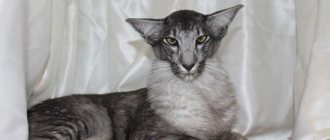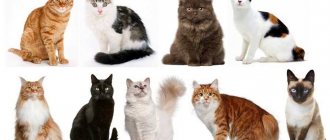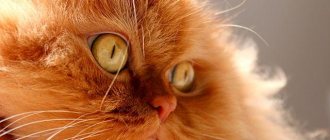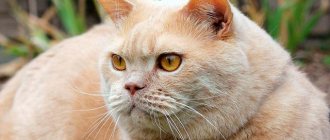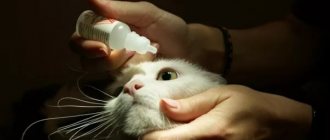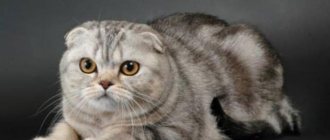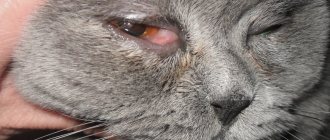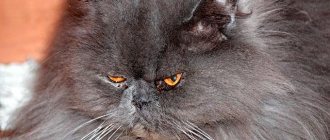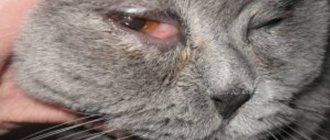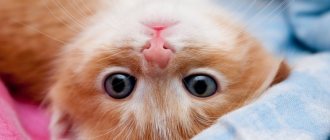Cats with heterochromia attract attention and arouse increased interest in everyone around them. Animals with eyes of different colors (blue and gold or emerald) look charming.
Breeders and ordinary hobbyists will need information about the name of the breed, where such an animal can be purchased, and in general, whether this feature is a criterion for identifying a separate breed.
Features of heterochromia
The word “heterochromia” is translated from Greek as “different color.” Heterochromes are animals whose irises have different colors. This phenomenon often occurs in humans. It is the result of either a lack or excess of melanin and its uneven distribution.
Variegation of eyes is a consequence of a gene mutation. It is safe and does not pose a direct threat to the health of its owner.
Heterochromia is rare in cats, but is not considered exceptional. Most often, this feature is found in animals with white and tortoiseshell colors.
Interesting! Cats usually have different-colored eyes: this phenomenon is rare among males.
How does it affect your pet's health?
As mentioned earlier, quite often, cats pay for the different color of the iris with hearing impairment, up to its complete loss. With an equal degree of probability, an animal may be deaf in one ear or both.
Single-sided deafness or significant hearing impairment in one ear and complete loss in the other are also possible. The phenomenon occurs if the cause of different-colored eyes is a genetic factor, which often disrupts the development of the hearing aid. But this is not a rule, and the animal may turn out to be full-fledged.
Deafness is not found in all cats with unusual appearance.
Because of this, before selling kittens, a conscientious breeder usually obtains a veterinary report on the condition of the animal. A kitten with partial or complete deafness costs less than a fully hearing one.
Types of odd eyes
Types of heterochromia:
- full: eyes of different colors, evenly colored;
- partial: the irises of the eyes are colored unevenly, segmentally.
In the first variant of the anomaly, the animal’s eyes are colored in different colors, one of which is blue. This coloring is not a pigment in itself; this eye color is a consequence of the lack of melanin in the iris. The other eye can be emerald, amber yellow, golden brown. The shade depends on the color of the cat.
Interesting! There is a high probability that kittens with different eyes can be born to almost any cat that has pure white or tortoiseshell individuals in its “family tree.”
With partial heterochromia, each eye is colored two colors. In this case, the paints are not mixed, but distributed “in sectors.”
Health of cats with heterochromia
Owners of pets with different-colored eyes need to remember the following nuances of furry health:
- If a blue eye suddenly turns red, your cat most likely has a bruise. The veterinarian will diagnose a broken vessel or hematoma, which should only be treated under the supervision of an experienced doctor.
- The color of the eye can change if melanoma grows or another neoplasm appears, a tumor located in the eyeball or fundus. Not every veterinarian is able to make an accurate diagnosis, so if you do not trust one doctor, consider him insufficiently competent, and the treatment does not give visible positive results, do not be afraid to consult another veterinarian.
Reasons for the anomaly
At the moment, scientists have not given a clear answer to the question of the causes of heterochromia. Some believe that this is an oversight of nature, others – a gene mutation. Only one pattern has been identified - the carrier of the anomaly is most often a white cat.
The gene responsible for this color (or rather, for its absence) determines the low content of melanin in the body and the possibility of its uneven distribution.
Eye color in cats has absolutely no effect on the acuity and quality of vision, but geneticists have identified an interesting feature.
Interesting! Snow-white cats were bred as a result of selection and inbreeding. This has had its consequences - they all suffer from complete deafness or have serious hearing problems. It is noteworthy that in white cats with heterochromia, hearing is impaired in the blue eye.
Divergence of eyes is a congenital feature. However, sometimes the color of one eye changes under the influence of certain circumstances:
- after injury;
- as a consequence of inflammatory processes;
- after prolonged treatment with certain drugs;
- as evidence of the development of oncology.
A change in the color of the iris of the eye in an adult cat is an alarming signal for the owner. This is a reason to consult a specialist for advice.
Interesting! Animals with different eyes and hearing impairment do not participate in breeding selection. They are culled to prevent the spread of genetically determined deafness in the breed.
Anatomy of a cat's eyes
A cat's eyes are large compared to the size of its head. As described in the MSD Veterinary Manual, the bony cavity or socket that contains the eyeball is called the orbit. The eye socket is a structure made up of several bones. The orbit also contains muscles, nerves, blood vessels, and structures that produce and drain tears.
© shutterstock
The white of the eye is called the sclera, which is the tough outer layer covered by the conjunctiva (a thin membrane). This covers the inside of the eyelids. In front of the eye is the cornea, a transparent dome that protects the eye and allows light to pass through.
The iris is the round colored area of the eye behind which the lens is located. The retina lines the back of the eye and becomes sensitive to light. This is what turns light rays into nerve impulses. The retina sends rays to the brain, which converts them into an image.
Light enters through the pupils, which quickly respond to changes in light. In the sun, your eyes will become small. In the dark they will expand so the cat can see.
Main breeds of odd-eyed cats
Unscrupulous breeders claim that the presence of different eyes in a cat is a sign of the breed. However, in reality it is impossible to predict the birth of an odd-eyed cat. The birth of a cat with different eyes is an accident.
However, in some cat breeds, the birth of kittens with different eyes is a common occurrence:
- Turkish van. The color of representatives of this breed is predominantly snow-white. Tortoiseshell is often found interspersed with white and red, gray, black and brown colors.
- Thai khao mani (translated as “white pearl”). In accordance with the standard, the color of representatives of this breed can only be white. Quite often, heterochromic kittens appear in a litter. Khao-mani are extremely expensive, so they used to live only in royal palaces.
- The Angora cat is the national pride of Turkey. White color is not the only color in the standard of this breed. There are black, cream and marbled specimens. The snow-white angora most often has different eyes.
Angora cat
Cats of these breeds are objects of increased interest among felinologists and exotic lovers.
Interesting facts about the breed
Some interesting facts to better understand these magnificent animals:
- most Angoras are not afraid of water; on the contrary, they love to swim;
- The appearance of angora dogs in Russia occurred at the end of the 18th century; several animals were presented to Empress Catherine II, at which time fame began to spread about the extraordinary fur of these animals. They were carded, and gloves and stockings were knitted from the wool.
- Despite their dislike of being held, Angora cats are dependent on human communication and have a hard time with separation. No matter what color the Angora cat is, it is always the standard of elegance and grace, an excellent companion and home decoration.
Other breeds that have heterochromia
Animals of different colors can have multi-colored eyes - for example, tortoiseshell with white spots. But the determining factor in the manifestation of discord is the presence of the “white gene”.
Breeds in which this feature is often found:
- Oriental. White cats of this breed are sophisticated and graceful. The most common combination of eye colors is blue and emerald.
- Scottish and British women sometimes bring snow-white kittens with different eyes. Usually blue is paired with copper color.
- Exotic and Persian cats are rarely snow-white. Usually the color contains multi-colored spots. Heterochromic kittens have blue and amber eyes.
- Sphinxes. Hairless cats can also be carriers of the “white gene”.
- Rex. This breed is distinguished by short wavy fur, large ears and huge eyes. The companion color is usually green or amber.
A British man with different eye colors
Heterochromia manifests itself even in outbred animals. Unfortunately, there have been no studies on this issue, so there are no statistical data.
Breeds with different eyes
A phenomenon called heterochromia occurs in several breeds of domestic cats.
Khao Mani
Khao Mani cats were originally bred in Thailand. The name “kao mani” translated means “diamond eye” or “white pearl”. At first, such animals were the property of the aristocracy, but over time they appeared among ordinary people. They are not cheap, so even today not everyone can afford to buy and keep such kittens.
This animal is characterized by a small body, the presence of a smooth coat, and an elongated muzzle. It’s not just its expressive appearance that made khao mani so popular. She is valued for her friendly, gentle character, sociability and ability to show affection. Caring for such an animal is no different: the cat is clean and not picky about its maintenance.
Keep in mind that you should buy a kitten if you are willing to devote a lot of time to it.
Loneliness is a pathological danger for an animal that he cannot stand, so there should always be someone in the house. The pet becomes attached to the owner and remains faithful to him. It is believed that it attracts happiness and prosperity to the home.
Angora cat
The Turkish Angora, as the Angora cat is called, is another species characterized by heterochromia. The animal has compact dimensions, small bones, and an elongated body with rounded ribs. A mature cat weighs 5 kg. The ears are long and erect. Common coat colors include: cream, white, black, blue, red. Felinologists are convinced that representatives of the Turkish Angora breed are more likely than others to have multi-colored eyes.
These cats appeared in Byzantium, and in the 16th century they were brought to Europe. Fluffies with white fur are considered popular; their cost is the highest. Buy such a kitten from nurseries, as these animals will live longer (18–20 years).
It is important to properly care for your Angora. Include biological supplements in your daily menu. Try to brush your pet's coat regularly, as well as clean its ears and trim its nails.
The cat has an active character, she can be trained and is always able to find something to do to her liking. Intelligence is inherent in Turkish Angoras because they remember basic tricks. They love to be the center of attention.
The best breeds of big-eyed animals
There are 3 types of eyes in nature:
The size, shape and location of the eyes are determined solely by the breed of the pet.
Round eyes
Almond-shaped
Slanted
Interesting facts:
- Cats with round eyes are the ones with the biggest eyes.
- Green and yellow are the most common colors.
- Blue-eyed tailed animals see worse in the dark.
Let's get acquainted with the biggest-eyed pets.
The Persian cat is one of the most popular breeds. It has large round eyes, a flattened muzzle and a “snub” nose, called “extreme”.
The price starts from 1,500 rubles from an amateur breeder without documents; a kitten from a nursery will cost about 5,000 rubles.
Persian cat Fluffy
The Scottish Fold (Scottish Fold) is a fairly common breed. The calling card is the animal's hanging ears. The eyes are large and round. The head is rounded with a slightly protruding jaw, the hair is short. Prone to obesity.
The Ukrainian Levkoy is a hairless cat that is gaining popularity. The eyes are almond-shaped, large, elongated. Appeared as a result of crossing the hairless Don Sphynx and the fold-eared Scottish Fold. This breed has no fur. The cost of a kitten without documents is from 5,000 rubles, the price in the nursery is from 20,000 rubles.
Ukrainian Levkoy
Devon Rex is a breed that is popular in European countries. Cats are loyal and trainable, which is why they are often compared to dogs. They have a short, curly coat that requires “polishing” with suede. Devon Rexes have a triangular face with huge, almond-shaped eyes and large ears.
The Singapore cat or Singapura is a rare breed. Miniature cat: the weight of an adult male is no more than 3 kg, females are no more than 2 kg. The eyes are large, almond-shaped, acceptable colors: green and yellow. The coat is short, ticking is required - alternating dark and light stripes in the hair color. The price starts from 30,000 rubles.
Character and psychology
The Turkish Angora is distinguished not only by its attractive appearance, but also by its social character.
The intelligent look of the Angora is not only an external characteristic. Turkish cats are really smart. With due diligence, it is possible to teach several commands, for example, to bring slippers, open and close the door.
The similarity with dogs is also manifested in the devotion of pets. The cat's love of love is enough for all family members. But the greatest affection will arise only for one person. Angora will be faithful to him until the end of her days. If separated for a long time, your furry friend may become withdrawn and lose his playful mood. The sensitivity of the Turkish woman is so strong that it helps to assess the state of mind of the owner. Adapt to it.
The Angora breed does not tend to sit for long periods of time in its hands. But the inherent desire is to be the center of attention. Angora is distinguished by non-standard cat sounds. No loud meows. The conversation consists of specific purring-uterine sounds. The cat will accompany them with almost all of its actions.
The sociable nature is evident even towards strangers. Angora welcomes you with Turkish hospitality
Every person will be treated with cat's attention
A calm mood easily gives way to a playful, robber state. Angoras easily make a mess. Of course, when you’re rushing around the apartment at the speed of light, it’s hard to notice what’s under your feet. More precisely under the paws. The breed definitely has a lot of energy. And love for tricks too. But for children, Turkish cats make excellent partners. Playing games together brings pleasure to both.
Good relationships also develop with other pets. But on condition that they recognize the Angora as the undisputed leader.
Hunting instincts manifest themselves in the desire to hide their treasures. The most unpredictable places are selected for this. Ambushing is also a favorite activity of the domestic predator.
